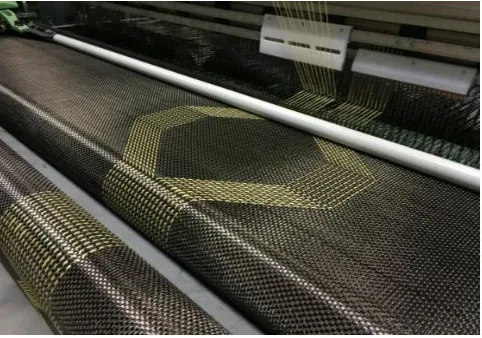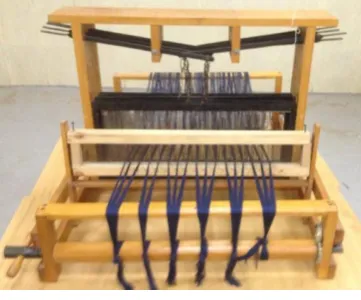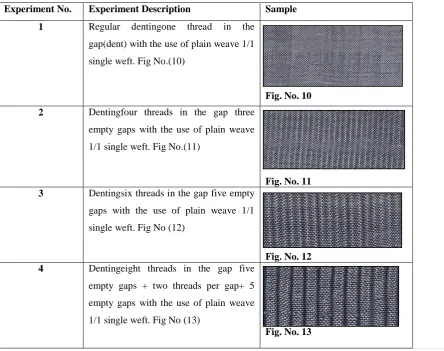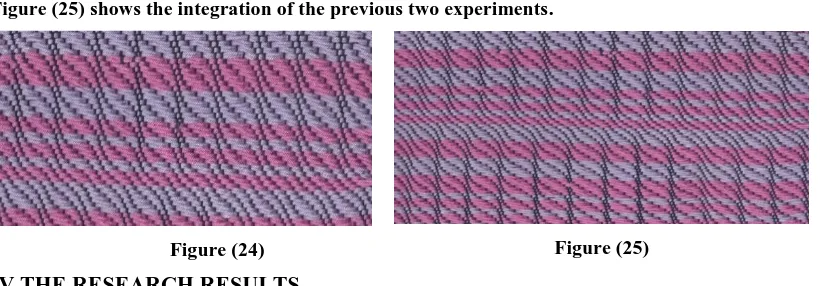221 |
P a g e
DEVELOPMENT OF TEXTILE EFFECTS ON DESIGN
USING THE OPEN REED WEAVING
Assist. Prof. Dr. / Heba AbdelAziz Shalaby
1Spinning, Weaving and Knitting Dept , Faculty of Applied Arts,
Benha University, Arab Republic of Egypt
Dr. / Adel Abdel Moneim Abd Allah Abo Khozaim
2Spinning, Weaving and Knitting Dept , Faculty of Applied Arts
Benha University, Arab Republic of Egypt
ABSTRACT
The reed is among the necessary elements to complete the weaving process, due to which the interlocking angle between allwarp and weft threads is90 degrees in case of not changingdenting throughout the weaving process. The aim of using the reed in the weaving machine has been to be a guide for passing the weft by shed in addition to beating up latter wefts to the former, as well as to maintain the width and keep woven warp density inlease rods.Hence the idea of research depends on the use of open reed, which is a comb with fixed lower (bottom) and an open upper part which can be opened and closed when changing denting during the weaving process. Several experiments have been carried out on the loom table equipped with four healds by using one warp, and the experiments have also been applied using plain weave 1/1 and twill weave 1/3.Experiments have shown that the change of denting during the weaving process makes it possible to change the interlocking anglebetween the warp and weft yarns to be less or greater than 90 degrees. New textile effects in a single sample design have also been obtained bymaking all factors invariable except the change of denting during the weaving process which was difficult to obtainby using the usual (closed) reeds. It was also possible to change the twill lines angle in a single sample of the twill fabric, and thus the open reed helps to get multiple textile and aesthetic effects.
Key words: Open Reed Weaving (ORW), Denting,Table loom,Twill angle
I INTRODUCTION
222 |
P a g e
rods. Until recently,none of the researchers addressedthe change of thecomb shape or the change of dentingduring the weaving process.
Reed Weaving
A reed refers to batten beats which push the filling yarn into place to make the fabric firm. A reed is a set of wires in a frame and wires varies between 3-5 millimeters wide andtheir thickness varies depending on the density and thickness of yarns used and the length of wires “combheight”rangefrom 11-15 cm (Abdel Samad, 1998). There are spaces between the wires in the reed which are termed dents. Warp yarns are threaded through these dents in the reed. The spacing in the reed is related to the desired number of warp yarns per inch in the woven fabric. Reeds are available with a wide variety of spacing according to the density of the yarns in the finished fabrics and the size of the yarns. For example, 20-dents reeds are used for low-density fabrics with coarse yarns whereas 80-dents reeds are used for higher-density fabrics with finer yarns. The way the reed beats the filling yarn in place helps determine the density of filling yarns and the grain characteristics of the finished fabric.Woven fabric is rolled onto the cloth, fabric, or take up beam as it is produced (Sara J. Kadolph, 2010). The use of reedinthe weaving machine aims to achieve the following:
1. Guiding the weft movement through the shed. 2. Joining the last weft yarn to the previous wefts. 3. Maintainingthe width of the woven fabric. 4. Making warp yarn density in centimeters fixed.
This is in addition to the stability of denting warp in the reed throughout the weaving process helps make the angle between the warp and weft yarns a right angle.
Reed Types
The reed wires are fixed within two upper and lower frames known in the textile factories as thereed bottomin a special system whichdetermines its number in the measuring unit, which varies to help change the thread thickness. Two basic types of reedscan be differentiated:
1. The reed with the circular section (the English), which was used in the shuttle machines the number of sessions for which does not exceed 160 picks/minute.
2. The reedwith the rectangular section (the French)which is distinguished from the English reed by its persistence, high endurance and ability to operate for long periods, as it is fit to run all types of light, medium and heavy fabrics.
223 |
P a g e
Figure (1) The reed with the rectangular section (the French)Reed Count
You can differentiate between all reeds of different qualitiesaccording to the number of dents in centimeters, known as “reed count”. In the past, there were several ways to give reed countwhich all disappeared and only one way remained to give the count directly by giving the number of dents per centimeter in the reed immediately. This way hasbecome the most common way in textile factories, due to its ease, giving the number of dents directly and accurately (Abdel Samad, pp. 340-344).
Denting
Dentsrefer to the spaces in the reed through which the yarns are threaded in groups of two, three or more depending on the number of ends per centimeter required, the type of yarn being used and the weave. Denting plays an important part in achieving a flawless fabric. Too many threads in one dent can cause breakages and reed spacing should be selected to be wide enough to allow a knot in the yarn to slip through easily.The number of dents per centimeter of the reed being used and the way the ends are dented determinethe number of ends per centimeter (Wilson, 2001, p.85).
Correct identification of denting threadsin reed dents plays a key role in improving the fabric appearance produced. The conditions that must be taken into account include:
1. The fabric repetitionshould begiven a correct number of reed dents as much as possible. For example, theplain weave 1/1 dentingmust be used in2 or 4 threads in dents.Ifit is given denting 3 in dents, this results in an apparent defect in woven fabrics known as splits.
2. When two fabrics with different longitudinal strips are used, the threads of the fabric weaves should not share the same dent.
224 |
P a g e
Open Reed Weaving (ORW)
The principle of function integration as indicated in Figure(2)1include: - The introduction of two additional yarn systems.
- The angle of additional yarns is adjustable.
Figure (2) Open Reed Weaving (ORW)
Open Reed Weaving (ORW) Process Figure (3)
II APPLICATION IN COMPOSITES
When used in composites, the open reed weaving gives: - High potential for efficient perform production. - Saving of production steps and waste in performing. - Reinforcement yarns can be placed according to load paths.
Product examples include local reinforcements, triaxial fabric and multiaxial profile reinforcement. Triaxial fabric and multiaxial profile reinforcement are shown in Figure (4).
1
225 |
P a g e
Figure (4): (A)Triaxial fabric(B)Local reinforcementsProduct potential:
Triaxial fabric:
The product potential in triaxial fabric includes two things. First, it continues load path in bias direction. Second, the angle of additional reinforcement direction is adjustable.
Possible application includes multilayer laminates quasi-isotropic laminates such as [0/90+45/-45/90/0] and saving of waste and performing cost by saving +/-45 laver.
Figure (5) Application of triaxial fabrics
Open Reed Weave (ORW) Technology (Weave and Stitch in one Process)
2The development of the innovative Open Reed Weave (ORW) technology by DORNIER led to the foundation for integrating completely new functions into the weaving process.System design requires a large technical effort in realizing patterns in the fabric surface. Floating threads that occur on the rear fabric side increase the surface weight. With technical fabrics, the fabric structure results in an anisotropic surface image which means fabric characteristics are not homogenous in all directions. Fabric strength and stretching behavior therefore strongly depend on the direction of activated forces.
ORW technology has an advantage of integrating additional threads into the weaving process by using special thread guides arranged between the reeds and weaving shafts. Linear drives shift the thread guides horizontally on a profile depending on the pattern. The additional pattern threads create a filling effect on the fabric surface that can be controlled as desired. This filling effect is similar to embroidery and Scherli patterns. ORW technology therefore offers more flexibility, pattern options domestic textile applications (e.g. curtains, tablecloths) and clothing materials.ORW technology is also a process for creating multiaxial fabrics for technical textiles. Arranging two axes driven independently allows weaving additional threads into the plain weave in any diagonal direction as 3rd or 4th thread systems. This adjusts the position of the diagonal threads to the direction of active forces .
2
226 |
P a g e
In addition to integrating extra thread systems in the plain weave across the complete fabric width, ORW technology can do this partially in order to integrate reinforcements required for specific fabric areas. Modular integration of the ORW unit retains the full productivity and unrestricted application spectrum of the weaving machine.
Figure (6) Weave and Stitch in one Process
From the previous studies, it is clearthat the use of open reed in the previous mechanical looms by using the warp formotifsthe denting of which is changed with a fixed denting warp for background. In theexperiment of the presentresearch,one warp is usedthe denting of which is changed in the reed during the weaving process.
III THE RESEARCH EXPERIMENTS
- The research experiments have been prepared on the table loom shown in Figure (7) using only four healds.
Figure (7) The table loom used in the research experiments
Figure (8) shows the open reed used
As shown in Figure (8) the open reedcount 5 inlease rods is used.
227 |
P a g e
Form (9) the method of operation, opening of the reed and the change of denting duringtheweaving process. - The warp used is acrylic cottonno. 12/4 and so are the wefts.
- Several exploratory experiments were carried out to determine the textile effect of the open reed. In these experiments,dentinghas been changed in several stages to find out the most effective use by using plain weave 1/1 and twill weave 1/3.
First: The plain weave 1/1 experiments using the open reedare illustrated in the following table: Table (1).
Table (1) illustrates the use of the open reedand plain weave 1/1
Experiment No. Experiment Description Sample
1 Regular dentingone thread in the gap(dent) with the use of plain weave 1/1 single weft. Fig No.(10)
Fig. No. 10 2 Dentingfour threads in the gap three
empty gaps with the use of plain weave 1/1 single weft. Fig No.(11)
Fig. No. 11 3 Dentingsix threads in the gap five empty
gaps with the use of plain weave 1/1 single weft. Fig No (12)
Fig. No. 12 4 Dentingeight threads in the gap five
empty gaps + two threads per gap+ 5 empty gaps with the use of plain weave 1/1 single weft. Fig No (13)
228 |
P a g e
5 Dentingtwelve threads in the gap +eleven empty gaps with the use of plain weave 1/1 single weft. Fig No (14)
Fig. No. 14 6 Dentingtwelve threads in the gap eleven
empty gaps for 12 picks then alternating between empty and filled gaps plain weave 1/1 single weft. Fig No (15)
Fig. No. 15
Analysis of Exploratory Experiments of Plain Weave 1/1 Using the OpenReed:
1. Denting change in asimple gradual waydoes not change the fabric appearance greatly. This can beshown by comparing the experiments (1, 2) (2, 3) , (3, 4) , (4,5) respectively.
2. It is possible to get the effect of longitudinal strips resulting from the difference in dentingin experiments 5, 4, 3 because of the large difference in dentinga strip from the other.
3. The weave effect was obtained in experiment 6 as a result of repetition of denting over 12 picks where denting occurs for 12 threads leaving 11 empty gaps with weaving 12 plain 1/1 picks and then alternating as shown in Table (2).In this experiment warp threads were curved giving an effect which was impossible to get using four healdsonly.
Table (2) Denting repetition over 12 picks in experiment (6)
Second:The twill weave 1/3 experiments using the open reed are illustrated in the following table:
Experiment No. Experiment Description Sample
7 Regular dentingone thread in the gap with the use of plain weave 1/3 single weft. Fig No (16)
Fig. No. 16 Warp Weft
12
threa
d
s
12 picks plain 1/1
11 empty gaps
12
threa
d
12 picks plain 1/1
229 |
P a g e
8 Dentingfour threads in gap three empty gapswith the use of twill weave 1/3 single weft. Fig No (16)
Fig. No. 16 9 Dentingeight threads in the gap five empty
gaps + two threads per gap+ five empty gaps with the use of twill weave 1/3 single weft. Fig No (17)
Fig. No. 17 10 Dentingtwelve threads in the gaptwelve
empty gapswith the use of plain twill weave 1/3 single weft. Fig No (18)
Fig. No. 18
Analysis of Exploratory Experiments of TwillWeave 1/3Using the Open Reed:
1. Denting change in asimple gradual waydoes not change the twillfabric appearance greatly. This can beshown by comparing the experiments (8, 7) - (2, 3) - (9, 8) - (10, 9) respectively.
2. It is possible to get the effect of longitudinal strips with twill resulting from the difference in denting in experiments 9, 10 because of the large difference in denting a strip from the other.
3. In experiments 10, 9 change of twill angle was observed depending on the denting in warp strips where the twill line becamewavy(curvy).
The angel of twill refers to the angel between the diagonal twill line and an imaginary horizontal line or axis parallel to the weft. This angle depends on the ratio between the ends/inch and picks/inch in the cloth. When the warp ends/ inch is equal to the weft pick/ inch, the twill angel will be 45° when the warp ends/inch exceeds the weft picks/inch the twill angel will be an obtuse angle i.e.>45 (high angle or steep twill). When the weft picks/inch exceeds the warp ends /inch, the twill angle will be an acute angle i.e. < 45 (low angle or flat twill). 3
Making Designs by Using the Open Reed:
In these designs the plain weave 1/1 and twill weave 1/3 were used.
First: Making Designs by Using Plain Weave 1/1:
An experiment was carried out (12 threads per gap +11 empty gaps) using weft coloursin the following order 6 pink + 6 mauve and repeat of the dentingover 18 wefts as in experiment (6). The result was as shown in figure (19), which explains the presence of interference effect due to the effect of open reeddesired to be shown.
3
230 |
P a g e
Figure (19)Therefore,double wefts were used in the order (4 double pink wefts +4 double mauve wefts) and repeat of denting every 12 picks as in the experiment (6). The effect was obtained as shown in figure (20). A and B represent the first design.
Figure (20) A and B
The second design was carried out in the same technique used in the first design with no dentingrepetition. The design was obtained as in figure (21) where longitudinal stripswere obtained.The two designs wereintegrated together to get the third design shown in Figure (22).
Figure (21) Figure (22)
Second: Twill 1/3 Designs:
A sample of twill 1/3 using the open reed in the order denting 12 threads per gap +12 empty gaps with different areas for crosswise wefts and using double wefts as illustrated in Figure (23), which gave the effect of longitudinal strips with twill.
231 |
P a g e
A change in denting during the weaving process was carried out, which gave thecurvy effect to the simple twill 1/3 carried out on the table loom with four healds and one warp as in Figure (24).
Figure (25) shows the integration of the previous two experiments.
Figure (24) Figure (25)
IV THE RESEARCH RESULTS
1. Change of denting in the same fabric sample gives aesthetic effects in the design of fabrics when the rest of the factors are invariable.
2. Effect of gradual difference in dentingin the same fabric sample does not appear greatly in design.
3. Change of denting during the weaving process by denting repetition over a number of picks then change denting led to getting curvy effect of warp threads much like bee hives.
4. Change of denting during operation in the open reed has changed the twill angle to give a curvyshape to the angle of the regular twill.
5. Using the open reed in the loom table equipped with four healds has given the possibility of changing denting during the weaving process which has given textile and aesthetic effects to the design of the productwhich cannot be obtained by the usual reed.
REFERENCES
1. Ahmed Abdel Samad. (1998).Textile technology. Faculty of Applied Art. Cairo. Egypt.
2. Board,Nlir. (2009). Thecompletetechnologybook: Textile, spinning, weaving, finishingandprinting. National Institute of Industrial Research. Amazon.
3. N. Gokarneeshan. (2009). Fabric structure and design. Senior lecturer dept. Textiletechnology Kumara Guru College of Technology, Coimbatore 641006.
4. Sara J. Kadolph. (2001).Textile. Prentice Hal, One Lake Street, Upper SeddleRiver,NJ 07458, USA. 5. Wilson, Jacquie. (2001).Handbook of textile design: Principles, processes and practice. CRC press
LLC, North and South America.
6. http://www.itma.com/docs/default-source/downloads/speakers-platform-presentations/15-nov.-day-1/8-christopher-lenz.pdf?sfvrsn.







